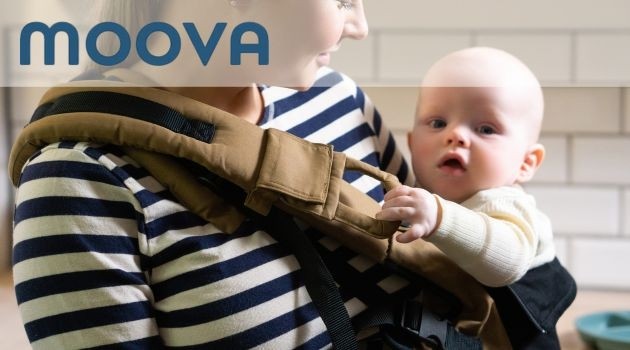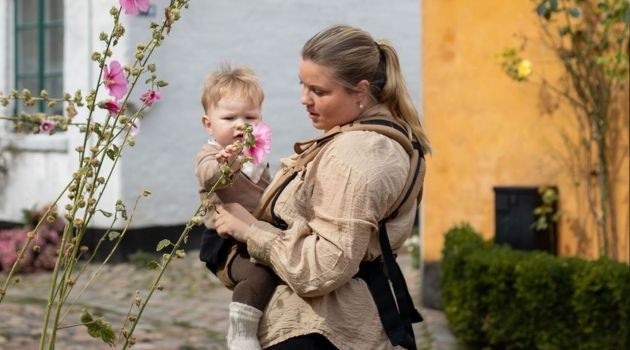Moova

About Moova
Moova is designed by Henrik Norholt. Through many meetings and discussions with leading international experts on baby behaviour and development, he has built up a wealth of knowledge on 'ergonomic babywearing'.
When he himself became the father of a baby daughter, he decided to devote himself to developing a baby carrier, unique in its kind ... and he succeeded, and how!
Carrying means security and has a positive effect on both psychological and biological levels. But what makes the Moova baby carrier so different? This innovative design aims to support and stimulate your baby's motor development right from the start!

CLOSE AND yet free
Moova has an adjustable back panel so that baby has freedom of movement as well as support (and rest). This freedom of movement activates the muscles and nerves in baby's head, neck, back, shoulders and arms. It also stimulates your baby's ability to sit upright and motor development!
After all, in this baby carrier a baby can easily turn his or her head to take in the outside world while having both arms and hands free to explore. This makes it very popular with curious and active babies! And ... Moova is designed to be fast, comfortable and easy to use, making it perfect for everyday use.
A win-win for young and old!
advantages of moova |
||
|
Stimulates motoric development |
|
Three ergonomic positions possible |
|
With adjustable back panel |
|
Suitable from 3.5 to 20kg |
|
Freedom of movement and support |
|
Certified hip-friendly by the International Hyp Displasia Institute |
Blog

First Aid for inconsolability
One of the many challenges of parenthood is trying to calm an inconsolable baby. Fortunately, there are a number of 'tricks' that can help! One of the best-known is rocking. This can, of course, be done in mum's or dad's arms... But today there are practical and safe aids available ... that leave your hands free for other things!
Read moreFAQ
Yes, wash at up to 30 degrees. Make sure all buckles are secure and excess strap ends are rolled up and enclosed by the elastic holders. If possible, use a laundry bag or else a pillowcase with a button or zipper. Hang to dry. Do not use a clothes dryer.
The Moova baby carrier is adjustable and can therefore be used by all parents.
We recommend using the supine position starting at about 6 months of age. Under no circumstances use the supine position until the baby can sit upright without support and has full control of his head. Many parents choose to use the supine position when their baby is about 1 year old because it often feels too heavy to carry in the front.
Most babies begin to actively stretch around 3 months of age and orient themselves more to the world. And by 3 months, most babies can hold their heads upright. Therefore, it is an excellent time to put your baby on your hip when doing things at home or on the go. It is very easy to move from the tummy to the hip position and vice versa. Your baby will undoubtedly enjoy being able to follow what you are doing.
We made a conscious decision not to carry the baby carrier forward for several reasons. We are convinced that the forward-facing position is the wrong solution to a real problem. The real problem for many babies in existing designs is that they are too enclosed and don't have enough outward visibility. This contradicts the instincts of many children and their urge to experience the world. Our solution is to give your baby enough freedom of movement and view in the optimal inward-facing position. So far, no baby has protested sitting in this position in the Moova baby carrier. At the same time, you support your baby's motor development.
You can carry your baby on your stomach, hip and back.
From when your baby weighs 3,5 kg to when he weighs 20 kg - usually around the age of 3-4 years.
Yes, you can. The parts your baby can come into contact with are all Oeko-Tex Standard 100 certified, including the super-soft cotton fabric.
It is a special zipper from the world's leading quality manufacturer, YKK. The type is called auto-lock and includes a mechanism that holds the slider in place until you actively pull the pull tab. The Moova baby carrier has been tested and certified by an outside testing agency to withstand a very large number of dynamic shocks from a 20 kg test dummy.
As long as your baby is comfortable and can stay warm when you are outside. However, always pay close attention to your baby's signals and make sure you don't keep your baby in the same position for too long.
Yes, as long as you adjust the height of the back panel to adequately support your baby's head.
Yes, the Moova baby carrier is ergonomic for both your baby and yourself. In the first month of life, you can choose to place your baby's feet in the panel so he is in the frog position, which means he is bent at the hip joint and there is not much space between the knees. This position is recommended by leading pediatric orthopedists. You can also adjust the width of the panel to support your baby's thighs and extend to both of your baby's knees, placing your baby's lower legs outside the carrier. This position places your baby in the optimal so-called M-position, where the knees are slightly higher than your baby's buttocks. This also applies to the hip and back position. The Moova baby carrier is pending approval by 'The International Hip Dysplasia Institute' as hip-friendly.
When babies resist being carried in a baby carrier or sling, it's usually because they feel too confined with too few options for movement. Moova's adjustable back panel allows you to give your baby the perfect amount of support and freedom. We have never heard of a baby not feeling comfortable in a properly adjusted Moova baby carrier. If you're in doubt and you have a baby with a history of discomfort in carriers, it's a good idea to try out the Moova baby carrier in a store.
Yes, it is very easy and safe to put your baby in the Moova baby carrier without the help of others. The Moova baby carrier is one of the easiest on the market thanks to its pre-set crossed shoulder straps and adjustable panel that you can zipper down when you put your baby in the carrier. This makes your daily routine a lot easier, since you'll likely need to get your baby in and out of the carrier several times a day when feeding, sleeping, sitting by yourself or when getting in and out of the car.

